Airfix 1/48 Spitfire FR XIVe
My fourth iteration of this kit (with one more left in the stash while I try to decide which markings/version to do). Did I mention I love this kit?
History:
t's a strange but interesting fact that the only "built for that specific powerplant" Spitfire to achieve a large production run was the Mk.I; while there were several other Marks specifically designed to make maximum benefit of the additional power of the later Merlins and then the Griffons, in each case the "interim" type cobbled together to bring the additional performance operational as soon as possible was the version that saw the most widespread production. This began with the Mk.V, which was essentially a beefed-up Mk.I airframe to take advantage of the Merlin 45's additional 400 h.p. This was followed by the Mk.IX, a beefed-up Mk.V to take advantage of the Merlin 60 series while the Mk.VIII was being designed to take maximum advantage of this engine. The last was the Mk.XIV, a beefed-up Mk.VIII airframe to use the Griffon.
The Spitfire XIV first arrived in the Southeast Asia Theater in June 1945. The first arrivals were F.XIV “highback” Spitfires, followed by F.R. XIVe “bubble-top” Spitfires. The aircraft all arrived just too late to see operational service in the war.
In the years following the war, RAF squadrons in Southeast Asia were reduced in number and run down in numbers of operational aircraft. Typical of such units was 28 Squadron, based at Kuala Lumpur Malaya. The Squadron would see operational combat service beginning in 1948 with the outbreak of the communist insurgency in Malaya and would be one of the last squadrons to fly the Spitfire in combat.
The kit:
Airfix's Spitfire XIV is the first really accurate 1/48 Spitfire XIV released, and is clearly superior to the Academy kits issued 20-some years ago. The kit can be turned into the F.XIV, F.R. XIV or F.R. 18 without difficulty. After a period of unavailability following the initial release this past summer, a second release came this past fall - not sure if it's an actual "second release" but it was better in detail than a couple of the first ones. The good news for these kits is that the quality control difficulties about warpage, short-shot parts and poor clear parts appears to have been dealt with.
Construction:
Several modelers have complained about the difficulty of building the kit without use of putty and with loss of detail. There is a very easy way to assemble this kit, such that one will have perfect fit and will use no putty or other filler in the process. Here it is:
-
Before assembling the fuselage, glue some Evergreen strip inside along the lower join line for the gas tank. Assemble the fuselage without attaching the cockpit. This allows you to work the fit of the gas tank to the fuselage from inside and out to get a perfect fit. If you take care in attaching the fuselage halves, you will only have to scrape down the centerline joint to have a smooth result. Before attaching the fuselage halves, cut open the side hatch if you want to pose it open on the finished model.
-
Assemble the cockpit. Cut off the ferschlugginah “gun sight” and make a Mk.14 sight, which is easy since it's a cube with an adjusting wheel on either side. All Spitfire XIVs used it and it solves the one “mistake” in the kit. (There are photos of the gunsight to be found on the net, google “photos of Mark 14 gyro gunsight”) I only used Eduard photo-etch seatbelts, the rest of the cockpit looks fine when it's viewed inside the fuselage.
-
Insert the cockpit into the fuselage, it will “click” into position, then glue it in place.
-
Assemble the main gear wells to the lower wing part, then glue the lower wing to the fuselage.
-
Carefully make sure that the inner edge of the upper wing part will fit perfectly to the fuselage, smoothing off the sprue nubs. Attach the upper wing by starting with the wing-fuselage joint, then glue the upper part to the lower.
-
Attach the horizontal stabilizer. Cut the elevators apart. Attach the plug in the vertical fin, then attach the elevators as you wish them posed.
-
Assemble and attach the radiators and housings and the carburettor intake. If you flood the area where these parts will be attached with liquid glue, it will fill any gaps and you will not need putty anywhere.
You now have a perfectly-assembled model, ready for paint.
Colors and Markings:
I chose to do a SEAC Spitfire XIV because I liked the Tropical Day Scheme many of the Spitfires carried. They originally arrived in India in the Temperate Scheme of Ocean Grey/Dark Green disruptive upper camouflage with lower surfaces painted Sea Grey Medium. Before being passed on to the squadrons, the Ocean Grey was painted over with Dark Earth. One good thing out of that is that the upper colors are “soft edge” because of the method of painting.
I first “pres-shaded” the model with flat black over the panel lines, then applied Tamiya Flat White XF-2 for the SEAC ID stripes, which I then masked off. I freehanded the camouflage pattern using Tamiya RAF Dark Green and Sea Grey Medium and my “custom mix” of Dark Earth. The paints were “post shaded” by adding in white and going back over the areas, to simulate tropical sun fading.
I used the kit decals for the stencils, while using the Xtradecals for the national markings and individual aircraft markings. I used the “arrowhead” for 28 Squadron from a different aircraft, since this was eventually applied to all 28 Squadron Spitfires.
When finished, I gave the model a coat of clear matte, then applied very limited ‘dings” with Vallejo Aluminum and a 0000 brush. Past that I didn't do a lot of weathering since the airplanes were not flown that often and were better cared-for in peacetime operations.
I then attached the exhausts, attached the landing gear and prop, unmasked the canopy and placed it in the open position.
Conclusions:
This is a very nice kit and makes up into the most accurate 1/48 injection-molded kit of the Griffon-powered Spitfire. Everything is there in the box to turn it into any particular sub-type of the “bubble-top” Griffon Spitfire. Xtradecals has released 48-127 and 48-130, which have some very interesting schemes for the Spitfire XIV, FR XIV and F 18.
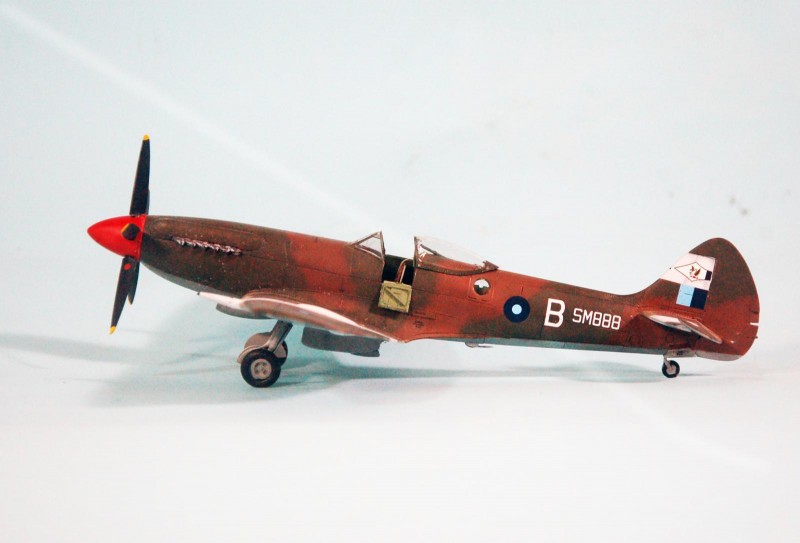

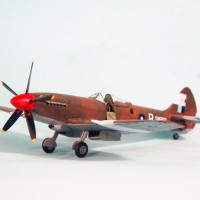
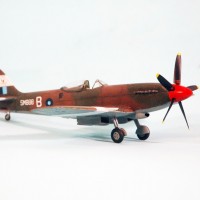

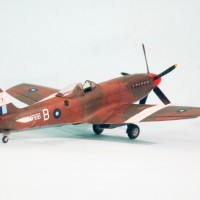
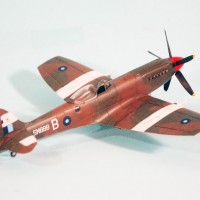
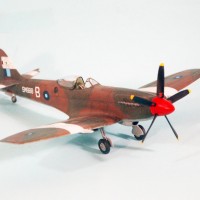
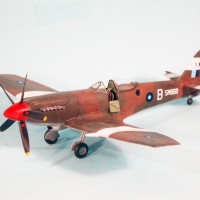
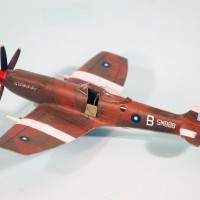
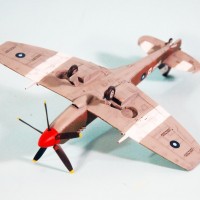
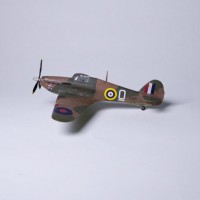

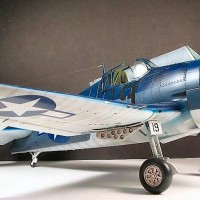
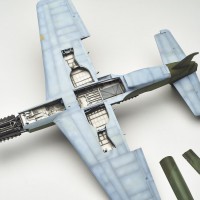
Another great model from this kit, Tom. Let’s hope they release a high back next year.
Yes indeed! With the PR XIX molds, they're nearly there.
" (My) “custom mix” of Dark Earth." Tamiya can't seem to turn the corner when it comes to making this color. It's too red or too brown or too British for Tamiya to see the color properly.
The Spitfire is the one subject that never grows old or stale. Griffon powered Spits, if you look at the radiators they are lot deeper and further out in the slip stream than their Merlin powered brethren . Had they develop something along the lines of the Mustang which used the Meredith effect with its radiator...the Spits would have eked out even more speed. I think this engine/radiator combination uses brute force to push this beast through the air. Nothing like the Merlin powered version. A Spitfire on steroids no doubt.
As usually another TC classic of a classic.
Two thumbs up.
Nice one Tom. I'm planning to go with this color scheme when I do mine.
As you can see, it's a good-looking scheme.
Really nice.
You did a great job with your Spitfire Tom, love it!
wow...you've really built a slew of these this year...i too love the CBI scheme...especially the hurricane on the back of the squadron signal book...those blue roundels are simply gorgeous
Nice one!
Another nice finish Tom - love asian theater markings! Well done.
Is it that addictive? I’m about to finish Academy’s “pregnant cat” and I try to fool myself, while looking at it, that the nose shape is not that bad...my kit dealer is about to receive a few of the new Airfix he just warned me. Just when I was trying to cut back my kit buying habit!
Great build, as usual! I like the oriental color scheme a lot.
Trust me, you'll love it. Follow my instructions for assembly and you'll be very very happy. Get more than one.
Now finally the Aeromaster decal sheet The last of the legend, Late far east Spitfires 48-549, got a worthy model. Included are one brown/green and a grey/green aircraft.